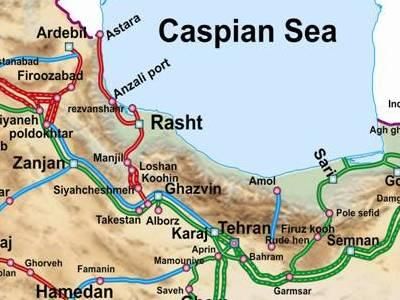By: Paul Goble
The Russian government long assumed that Western sanctions on Iran would allow it to steal a march on the world by expanding its railroad connections to the south via the Islamic Republic while simultaneously ensuring that the South Caucasus remains a Moscow-dominated hub for both east-west and north-south rail transit (see EDM, February 20, March 24). But China has responded by expanding its own westward rail connections through Central Asia—and not only across the Caspian Sea, as Moscow expected, but via Iran as well (see EDM, April 23). As a result, Russia now appears to be losing out in the regional “railroad wars” (see EDM, August 1, 2017). Illustratively, a subsidiary of Russian Railways has recently announced it is suspending its infrastructure projects in Iran, including critical portions of the north-south route (Old-press.rzd.ru, April 2).
Russian Railways claims this suspension “will not influence the development of partnership relations between Russian and Iranian railroads,” because other projects, including the electrification of the Garmsar–Inche–Burun line, are continuing. Clearly, however, Russia’s position in the Iranian railroad sector has weakened, to the alarm of officials in both Moscow and Tehran—but likely to the satisfaction of those in Beijing (Kaspissky Vvestnik, May 1). Last week (May 1), Vlad Kondratyev, the well-connected editor of Kaspissky Vestnik reported that the Iranian ambassador to Moscow, Kazem Jalali, held a video conference with Sergey Pavlov, the first deputy head of Russian Rail, to talk about the future (Kaspissky Vvestnik, May 1). According to the Iranian embassy, they discussed the project’s suspension (Russia.mfa.gov.ir, April 29).
According to the Iranian side, Pavlov stressed “the importance of multilateral cooperation for the activation of the north-south corridor and declared that the [Russian] government supports this project.” It is clear, however, that the Iranians are concerned about the Russian suspension of its infrastructure assistance program. The best result the Russians and Iranians could point to following the meeting was to say that “the sides have agreed on a continuation of contacts” (Russia.mfa.gov.ir, April 29).
Yet, in his assessment of this meeting, Kondratyev is far blunter. He says that “by all appearances, Russia and Iran are ending cooperation on one of the most important joint projects, the electrification of the Garmsar–Inche–Burun rail sector.” That outcome, he suggests, is clearly being driven by the current economic crisis: only two months ago, Russian and Iranian officials were saying that Russian aid would be forthcoming and the project would take off. Obviously, that is not happening (Kaspissky Vvestnik, May 1).
The Kaspiisky Vestnik editor insists that all is not lost—Russia has not backed out of its support of the Rasht–Astara portion of the Iranian rail network. This portion’s completion would make possible, “at long last,” the direct railway connection of Russia, Azerbaijan and Iran. Moreover, he suggests that the line Moscow has decided to stop funding upgrades on (i.e., Garmsar–Inche–Burun) is, “to a certain extent,” a competitor of the Rasht–Astara route. Therefore, Kondratyev argues, “it is not excluded that under conditions of the growing worldwide economic crisis, Moscow and Tehran will agree to concentrate their resources on the Rasht–Astara line, which,” he insists, “more fully corresponds to the mutual interests of the two sides.” Planned Rasht–Astara Railroad (Source: Xalqqazeti.com)
Planned Rasht–Astara Railroad (Source: Xalqqazeti.com)
 Planned Rasht–Astara Railroad (Source: Xalqqazeti.com)
Planned Rasht–Astara Railroad (Source: Xalqqazeti.com)
That is, of course, possible; but a more likely outcome is that Iran will turn to the Chinese for financing, fearful that Russia, having withdrawn from one project, will withdraw from others. Beijing has signaled it is quite prepared to do so, given that trade between China and Europe would be quicker and cheaper if it could go by rail through Iran rather than have to be offloaded onto ships to cross the Caspian and then be reloaded onto trains in the Caucasus. Tehran may feel it has no choice but to accept Chinese funding, even though it has made clear that its interests lie more in the development of the north-south route that Moscow backs than in the east-west one that Beijing prefers (see EDM, April 23).
If this happens, as now seems likely given Russia’s increasing economic difficulties, it will have three potentially major geo-economic and therefore geopolitical consequences. First, it will almost certainly end Chinese interest in using Russian routes for its trade with Europe, thus eliminating one of the pillars Moscow had relied on to cement a new alliance with Beijing. Moscow may still move toward such an arrangement, but it will have less to bring to the table and may have to make more concessions to China. Second, it is likely to mean that China will be even more capable of guaranteeing its dominance over rail traffic in Central Asia and the South Caucasus. This outcome will challenge Moscow’s position in both regions and possibly reorient the foreign policies of at least some of those countries away from Russia (and from the West as well) and toward China. And third, and not unimportantly, it will give China greater opportunities to project its rising power into the Middle East.
These are all developments that many not only in Moscow, but also in the West, do not want to see; and consequently, it is likely Russia may try to revive its cooperation with Iran by focusing on other issues, including the sensitive nuclear deal, as Foreign Minister Sergey Lavrov did in his talks with his Iranian counterpart, Mohammad Javad Zarif, at this year’s Munich Security Conference (Mid.ru, February 15; Kommersant, February 16). The West, in turn, has fewer levers—after all, Western sanctions are what prompted Tehran to turn first to Moscow and then to Beijing. But Europe and the United States will likely seek other means to block this latest manifestation of the rise of China as well as the associated return of Iran to active geopolitics.
No comments:
Post a Comment